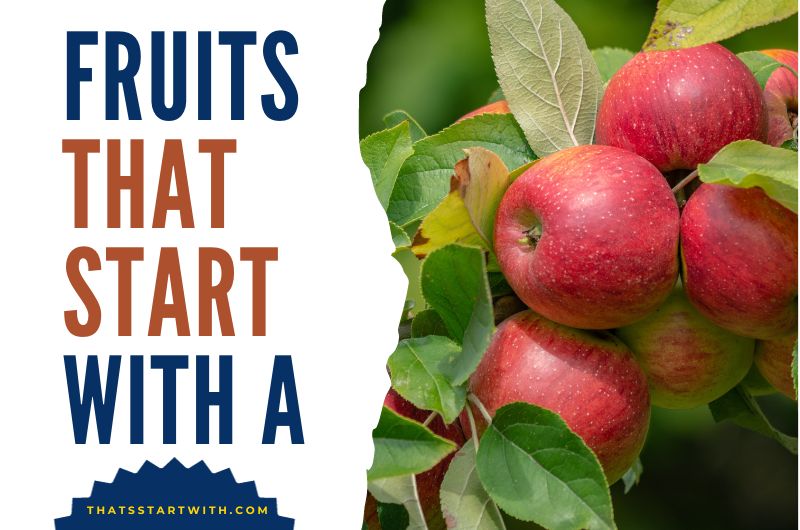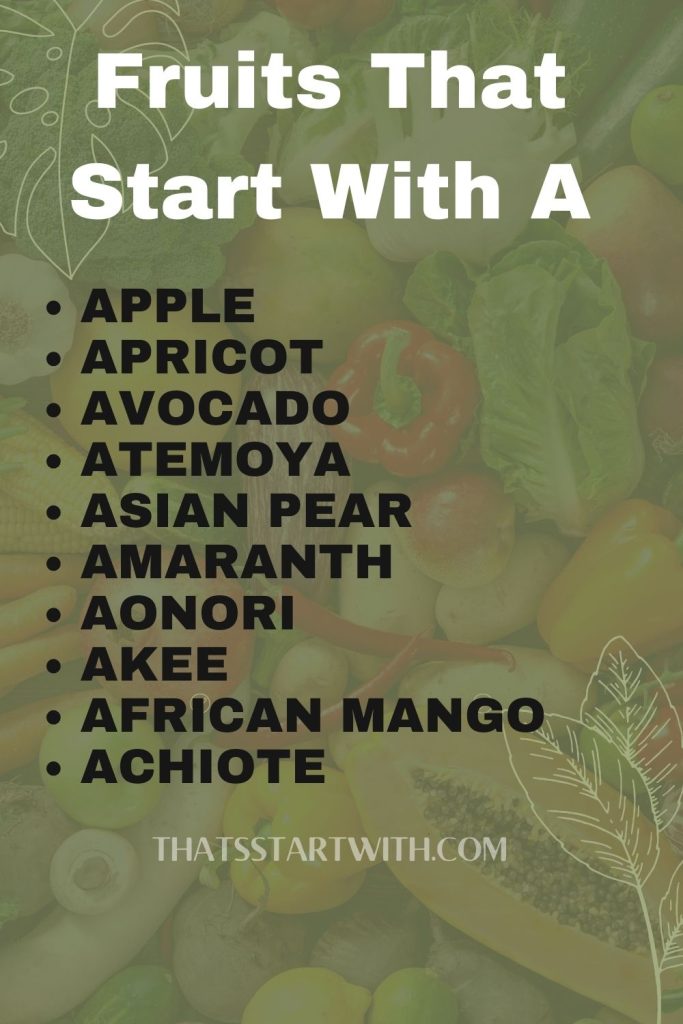
Fruits are nature’s delectable treasures, offering a burst of flavors, vibrant colors, and essential nutrients.
Among the diverse array of fruits that start with A hold a special place, contributing their unique tastes and nutritional benefits to our culinary experiences. From the crisp and juicy to the sweet and succulent, these fruits not only tantalize our taste buds but also play a crucial role in promoting overall health and well-being.
In this exploration of fruits that start with A we delve into a delightful assortment that showcases the richness and diversity found in nature’s orchards.
Whether enjoyed on their own or incorporated into various dishes, these fruits add a refreshing and wholesome dimension to our diet. Let’s embark on a journey through the orchards and discover the extraordinary world of fruits that begin with the letter “A.”
Fruits That Start With A

Apple:
Apples, crisp and refreshing, are one of the most popular fruits worldwide. With a variety of flavors and textures, they are not only a tasty snack but also a versatile ingredient in both sweet and savory dishes.
Apricot:
Apricots, with their velvety skin and sweet flesh, bring a burst of summer flavor. Packed with vitamins and antioxidants, these golden gems are a delightful addition to fruit salads and desserts.
Avocado:
Avocado, known for its creamy texture and rich taste, is a unique fruit prized for its versatility. Whether spread on toast, blended into a smoothie, or sliced in a salad, avocados are a nutrient-dense powerhouse.
Açaí Berry:
The Açaí berry, native to the Amazon rainforest, is hailed for its antioxidant-rich properties. Often enjoyed in smoothie bowls, this deep purple fruit adds a delightful and healthful touch to your diet.
Atemoya:
Atemoya, a cross between cherimoya and sugar apple, boasts a luscious, custard-like texture. With a sweet and tropical taste, it’s a lesser-known but delicious addition to fruit aficionados’ repertoires.
Ackee:
Ackee, the national fruit of Jamaica, is known for its buttery consistency and mild flavor. Often enjoyed in savory dishes, it is a crucial ingredient in the traditional Jamaican dish, Ackee and Saltfish.
Asian Pear:
Crisp and juicy, the Asian pear offers a refreshing alternative to its European counterparts. With a sweet taste and a texture resembling both apples and pears, it adds a delightful crunch to salads and desserts.
African Horned Cucumber:
Also known as the kiwano melon, this spiky fruit with vibrant orange skin and jelly-like interior is a unique addition to exotic fruit salads. Its mildly sweet and tart flavor makes it a culinary adventure.
Amaranth:
Amaranth, often considered a grain, produces tiny edible seeds. Packed with nutrients, it’s a wholesome addition to various dishes. The plant also yields vibrant amaranth leaves, a nutritious leafy green.
Arctic Kiwi:
Smaller than the traditional kiwi, the Arctic kiwi, or baby kiwi, is a sweet and tangy fruit with smooth skin. Eaten whole, it’s a convenient and delicious snack, providing a burst of vitamin C.
Aonori:
Aonori, a type of edible seaweed, is used as a condiment in Japanese cuisine. With a savory umami flavor, it adds depth to dishes like soups, noodles, and rice.
Almond:
Though often mistaken for a nut, the almond is actually the seed of the fruit of the almond tree. Known for their nutritional value, almonds are enjoyed raw, roasted, or as a versatile ingredient in both sweet and savory dishes.
Akee:
Akee, the national fruit of Jamaica, is known for its pear-like shape and vibrant red exterior. When ripe, it reveals creamy yellow flesh and is a key component in the traditional Jamaican dish, Ackee and Saltfish.
African Mango:
African mango, or Irvingia gabonensis, is a fruit native to West Africa. Its seeds, known as dika nuts, are edible and are often ground into a paste or used in traditional African cuisine.
Alligator Pear:
Alligator pear is another name for avocado, emphasizing its textured skin resembling that of an alligator. This versatile fruit is celebrated for its creamy consistency and heart-healthy monounsaturated fats.
Ambarella:
Ambarella, also known as June plum or hog plum, is a tropical fruit with a sweet and tangy flavor. Often eaten fresh or used in chutneys and preserves, it adds a tropical flair to culinary creations.
American Persimmon:
Smaller and sweeter than its Asian counterpart, the American persimmon is a native fruit with a honey-like taste. Whether enjoyed fresh or in baked goods, it’s a seasonal delight.
Achiote:
Achiote, also known as annatto, is a fruit with vibrant red seeds used as a natural food coloring and flavoring agent. Commonly employed in Latin American and Caribbean cuisines, it imparts a warm, earthy taste.
Abiu:
Abiu, a tropical fruit with smooth yellow skin, is revered for its sweet and translucent flesh. Hailing from South America, it’s a delicacy enjoyed fresh or incorporated into desserts.
Asaí:
Asaí, pronounced ah-sigh-EE, is a small, purple fruit from the Amazon rainforest. Widely popular for its antioxidant-rich properties, it’s often consumed in smoothie bowls or as a refreshing juice, contributing to both taste and well-being.
Related Articles:
Conclusion
In the world of fruits that start with A offer a diverse and tantalizing array of flavors, textures, and nutritional benefits. From the familiar and beloved apple to the exotic and lesser-known varieties like açaí and atemoya, these fruits contribute not only to our culinary experiences but also to our overall health and well-being. The journey through the orchards of apples, apricots, avocados, and more reveals a rich tapestry of tastes that span continents and cultures.
These fruits serve as more than just delightful snacks; they are ingredients that inspire creativity in the kitchen. Whether adding a creamy richness to a dish with avocado, enhancing the sweetness of a dessert with apricots, or infusing a tropical twist with açaí, the fruits that begin with “A” bring versatility and vibrancy to the table.
Greetings, I’m Andrew Miller, and I’ve initiated this blog to assist individuals in discovering a wide range of things alphabetically, from A to Z.